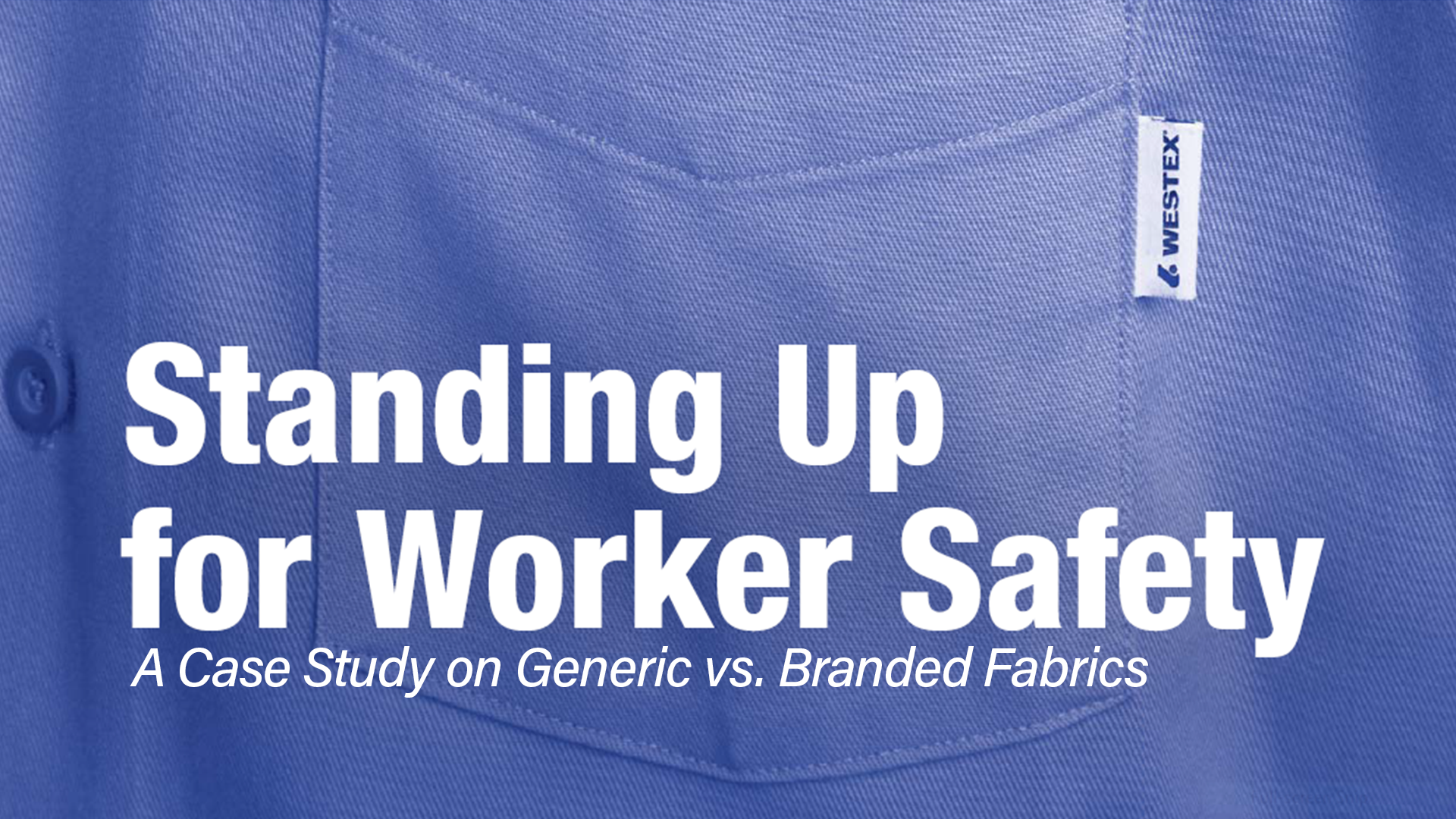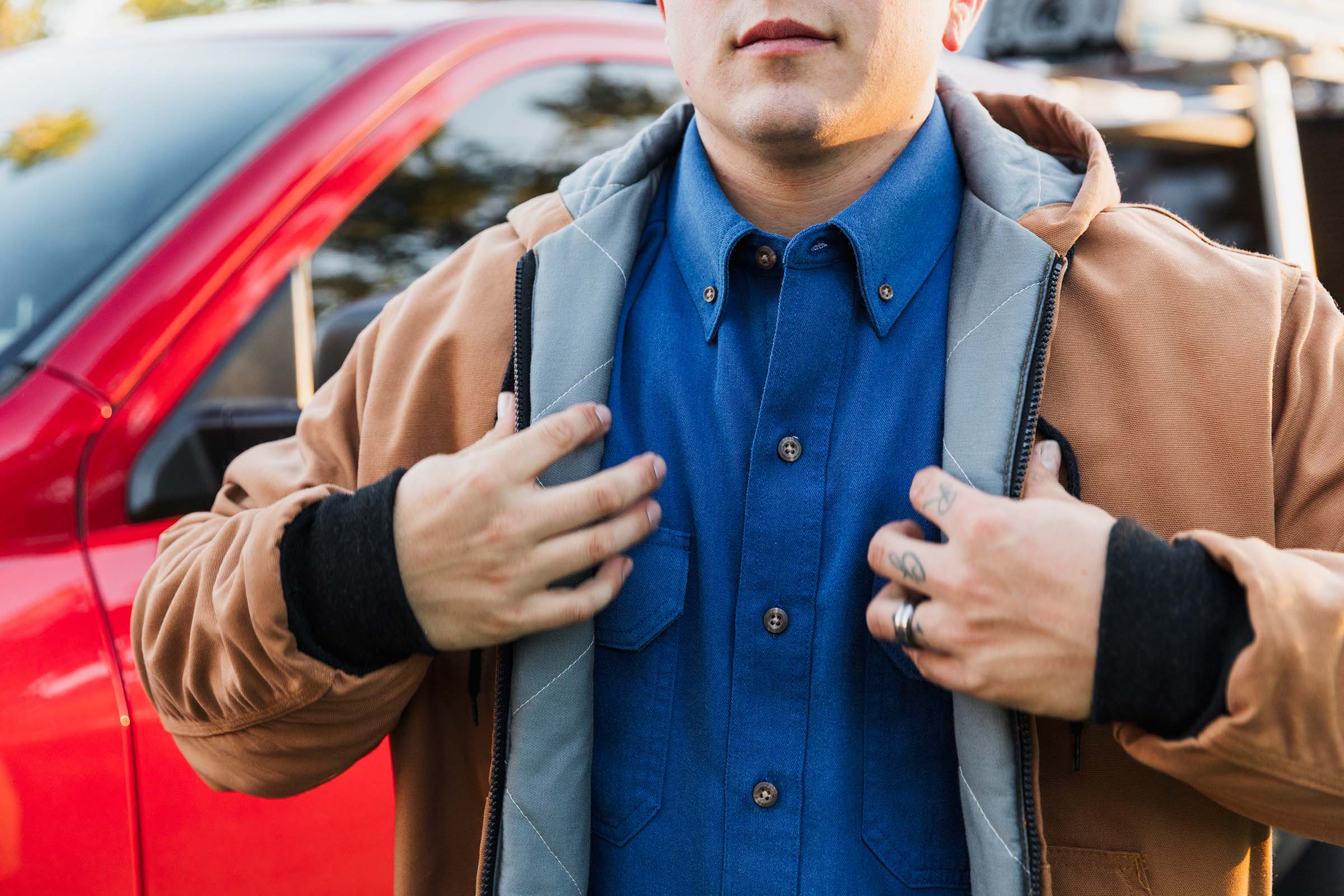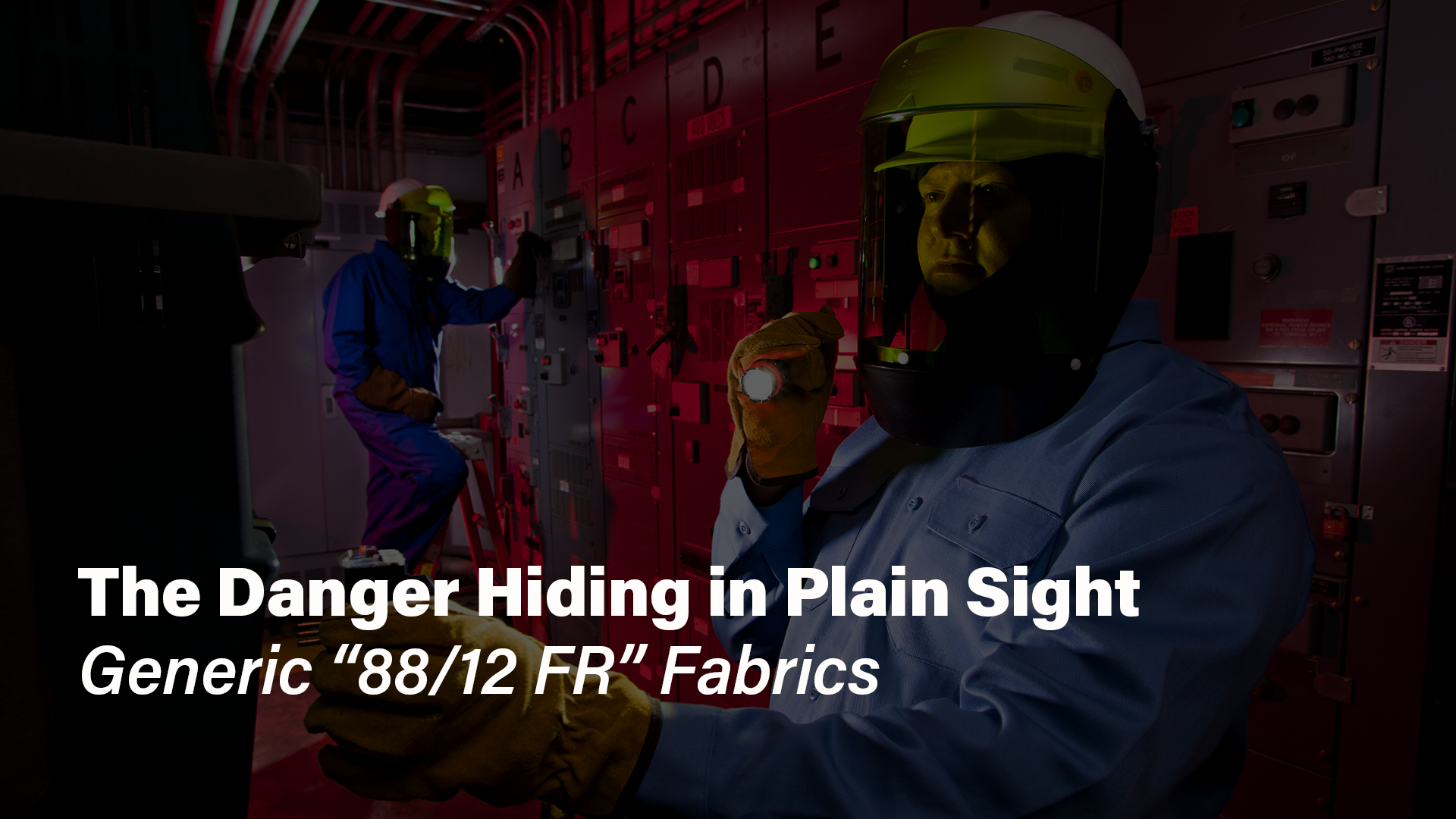
Standing Up for Worker Safety: A Case Study on Generic vs. Branded FR Fabrics
GeneralArc Flash VideosFR Fabric Education 29 Aug 2017
When Dan joined an American company as Environmental Health and Safety Manager, his team leader and Director of Environmental Health and Safety, Robin, immediately informed him that the field employees, had a high exposure to arc flash over the course of their daily operations. The company’s 1,500 field technicians interact daily with electrified equipment– and have families, spouses, and children who wait for their safe return from work after a long day.
An advocate for safety in all forms, Robin tasked Dan with creating a flame resistant (FR) program to protect field technicians against unexpected arc flashes – electrical explosions or discharges traveling through the air between conductors or from a conductor to ground, which can cause severe burn injuries and even fatalities. She recognized the overwhelming hazards facing company employees, and tapped into Dan’s FR knowledge to create a program placing employee safety front and center.
After successfully implementing an FR program at his previous company, Dan keenly understood the need for top management’s support to fund the investment required for a daily FR workwear program. Dan, with Robin as his advocate in C-suite discussions, sought to leverage education in garnering leadership buy-in.
The process ahead was clear:
- Make the hazard of arc flash known
- Communicate why FR programs are necessary, detailing the rules and regulations of NFPA 70E, and what that means for employers
- Identify the ideal FR workwear solution for arc flash, starting with the fabric itself
- Implement the program for field workers to adopt
Dan and Robin ultimately knew the conversation would come to a question of cost – but they weren’t willing to compromise safety. This case study details how Robin and Dan put their jobs on the line to create the most reliable FR program for technicians, using Westex® brand FR fabrics.
“I couldn’t live with myself if I knew that a decision I made caused someone harm or death. I’ll do whatever it takes, including putting my job on the line, to ensure that the associates I’m responsible for have access to the most effective FR workwear. Their protection is my priority.”
-Dan, Environmental Health and Safety Manager
Arc Flash Hazards on the Job
The company previously had an arc flash incident, but they didn’t know that it was one. There were no environmental health and safety policies and procedures in place, so the first task at hand was informing everyone of the arc flash hazards facing technicians.
The need for FR apparel was already regulated by NFPA 70E: Standard for Electrical Safety in the Workplace, which requires companies to perform a hazard risk analysis for employees working on or near energized parts of equipment. If the assessment determines that present energies exceed 2 cal/cm2, then workers shall wear protective, arc rated AR/FR clothing with a proven arc rating equal to or greater than the anticipated level of energy.
To comply with the NFPA 70E standard, employers are required to perform a hazard analysis. Where required, employees shall wear AR/FR protective clothing that meets ASTM F1506 – the minimum performance specifications for protective clothing for workers exposed to the risk of electrical arc flash.
A hazard analysis was performed at Dan and Robin’s company, which revealed field technicians should wear apparel with an ATPV or arc rating equal to or greater than 8 cal/cm2 under 600v energies.
The company also services industrial customers in chemical plants and refineries, which presents a second hazard of flash fire. To account for this hazard, Dan and Robin would only consider FR fabrics that meet the entire NFPA 2112 standard, which mandates that FR apparel be flash fire tested at 3 seconds with a pass/fail rate of 50% total body burn under the protocols of ASTM F1930-15: Standard Test Method for Evaluating Flame Resistant Clothing Against Flash Fire Simulations Using an Instrumented Manikin.
Specify the Fabric First
For the bidding process, the team contacted multiple FR fabric manufacturers looking for the most cost-effective solutions. They provided generic variations on Westex UltraSoft®’s comfortable 88/12 cotton and nylon blend. Shockingly, six vendors were dropped immediately because they could not guarantee that the fabric would meet the entire NFPA 2112 standard for flash fire hazards while also meeting the ASTM F1506 standard for arc flash.
Research and wear trials were key in selecting the most appropriate FR solution. Comfort is essential to have workers adopt FR apparel – FR apparel cannot detract from their ability to perform their job responsibilities. Twenty-five associates were involved with the wear trials.
Throughout the process, Westex® brand fabric immediately stood out:
- Westex UltraSoft® is not only NFPA 2112 certified, but provides up to 9% body burn
- Flame resistance is guaranteed for the life of the garment
- Technicians felt comfortable and could easily work in apparel made with Westex UltraSoft®
- Uniforms made with Westex UltraSoft® are more durable against snagging, a critical factor as technicians are often work in small crawl spaces
Convincing Management
Westex UltraSoft® outperformed other “88/12 FR fabrics” in the wear trial and was the overwhelming favorite among associates wearing the FR garments; but unfortunately, the selection process does not end there. Once Westex UltraSoft® was identified as the FR fabric of choice, the next hurdle was gaining management’s approval. Everything was a becoming a question of cost, rather than quality.
Robin and Dan immediately received push back on the price of generic versus branded FR apparel, such as Westex®, but they did not give up. It came to a point to where the team took a stance that couldn’t be ignored: they felt so strongly about creating the best FR program for their associates that they would both leave the company if FR apparel other than Westex® fabric was chosen.
“As an EHS professional, there are certain things on which I am willing to bend, but I absolutely will not compromise a person’s safety. I feel strongly about protecting my people.”
-Dan, Environmental Health and Safety Manager
Support from Westex by Milliken, including attending multiple meetings with senior staff and management, was essential in educating team members on how Westex® fabrics outperform other options in the industry. Jeff DuLong, Westex by Milliken Regional Market Manager, provided key information differentiating Westex® from competitors, including potential gaps for misunderstanding within the standard itself – such as the 50% body burn requirement, which leaves a significant range of protection.
Jeff’s expertise helped navigate the nuances of various manufacturers, including those made in America versus overseas. It was even revealed that a foreign fabric, while labeled NFPA 2112-certified, was not actually certified to the standard. The entire process of bringing management on board took almost three years, but it was worthwhile.
“Westex by Milliken has a superior product and very knowledgeable associates who help however needed. Jeff was key for turning the tide.”
-Dan, Environmental Health and Safety Manager
Feedback from the Field
Now that Westex by Milliken is the company’s standard FR solution, the question isn’t a matter of which uniform they specify, but a matter of which style – such as color or fabric weight. Whatever the style, it is ingrained that it has to be a Westex® fabric.
Today, the company supplies a range of apparel made with Westex® brand FR fabrics to employees, including Westex® DH, Westex IndigoTM as a denim option, and Westex UltraSoft® as shirting fabric and basket weave fabric for pants.
The process of creating an FR apparel program has also allowed the company to standardized uniform to visually unify technicians at the same location and throughout the country, while taking regional conditions into account.
Employees in sunny Florida work in hot, humid environments, so Westex by Milliken has helped the company select lightweight, breathable FR apparel featuring Westex® DH fabrics. They also specified darker colored fabrics so that uniforms do not show dirt. Westex® DH is receiving incredible feedback from employees who wear it daily; it has a soft hand, wicks well, and cools faster than other shirts providing FR protection.
The last step in implementing the company’s FR program was to educate employees on the need for a streamlined FR workwear uniform. Dan and Robin used a combination of videos to educate associates on potential dangers on the job, and demonstrate why and how the new Westex® work uniform would help protect them. They also included the benefits of the new Westex® workwear in their company newsletter, which they send to their associates’ homes. As you can imagine, spouses and family members were encouraged by how the company was prioritizing the safety of their associates – clearly seen in how they chose to invest in a reliable FR program.
Conclusion
Nothing is more rewarding for Dan than being a part of implementing a positive and effective change.
“We grow up and work in fashion to where we stick with the status quo until someone gets hurt – and then you try to do it differently,” Dan shared. “I enjoy teaching people how to look at a situation differently and find the most effective solution upfront. That’s why we chose Westex by Milliken to be our FR program partner.”
Dan is confident that Westex by Milliken provides the premier FR apparel, and he is vocal about his belief:
“I’ll stand in front of anyone and say that Westex® is the best FR apparel for protecting an employee. I’ve seen it in action, I’ve worn the pieces, and I’ve tried FR apparel from other manufacturers. Westex® always outperforms other fabrics – and our expectations.”
Dan has since transitioned to a new company, still working in environmental health and safety management. He is taking Westex® with him.
The information in this publication is based on testing conducted by or conducted on behalf of Westex, Inc., a subsidiary of Milliken & Company, and represents our analysis of the test results. It is not intended to substitute for any testing that may be unique and necessary for your facility for you to determine the suitability of our products for your particular purpose. Since we cannot anticipate all variations in enduser conditions, Westex, Inc. makes no warranties and assumes no liability whatsoever in connection with any use of this information. As each customer’s use of our product may be different, information we provide, including without limitation, recommendations, test results, samples, care/labeling/processing instructions or marketing advice, is provided in good faith but without warranty and without accepting any responsibility/liability. Any test results reported are based on standard laboratory testing but should not be used to predict
performance in actual fire situations. Each customer must test and be responsible for their own specific use, further processing, labeling, marketing, etc. All sales are exclusively subject to our standard terms of sale posted at www.milliken.com/terms (all additional/different terms are rejected) unless explicitly agreed otherwise in a signed writing. Use caution near sources of flame or intense heat and do not launder with bleach or fabric softeners. Westex®, UltraSoft® and Milliken® are all registered trademarks of Milliken & Company. Indigo is a trademark of Milliken & Company.

